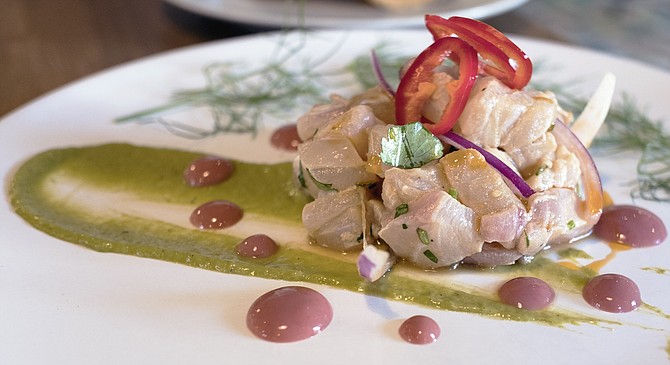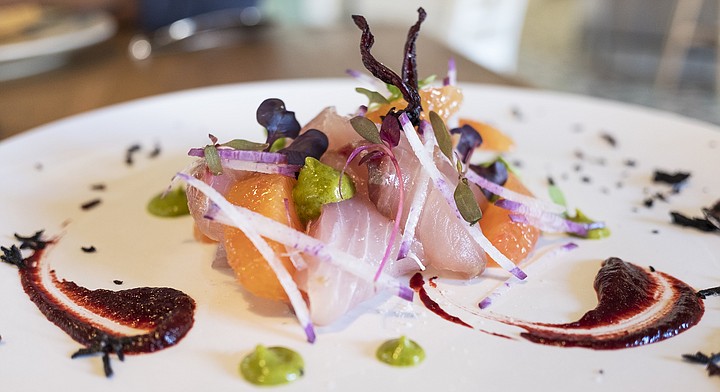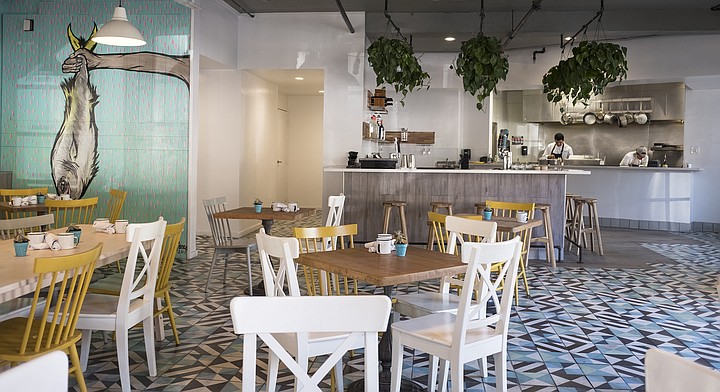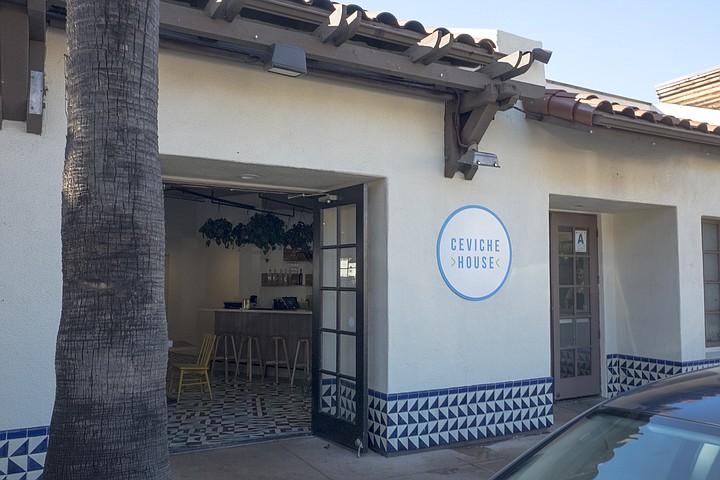 Facebook
Facebook
 X
X
 Instagram
Instagram
 TikTok
TikTok
 Youtube
Youtube

When we last saw Ceviche House, chef Juan Carlos Recamier's business had graduated from farmers market stall to a tiny counter service shop in North Park. Not even two years later, Ceviche House took another step forward this fall, moving into a much larger space in Old Town. In doing so, it's transitioned from overachieving fast casual hole in the wall, to buzzy table service restaurant.
Though still breezy and laid back, the new place offers decidedly more elegant iteration of the Peruvian seafood concept. A significantly roomier and better appointed kitchen has allowed Recamier to expand the menu of hot dishes. However, ceviches and tiraditos are still the main lures, and both have been elevated in presentation and execution. Glistening slices of tender fish are arranged in picturesque platings, dressed by fruit purees, chili peppers, and microgreens.

The seafood still hails from reputable local sources — typically Catalina Offshore Products or Tuna Harbor Dockside Market — and it's served at ideally chilled temperatures. Menu options vary depending on season availability of both seafood and produce, and during a recent lunchtime visit, I opted for the chef's daily selection of ceviche: grouper, served with fresh fennel, strawberry rhubarb and avocado purees, and slices of Fresno chili.

I'd enjoyed the clean sweetness of grouper sashimi recently, and liked it even better as a ceviche for $11. The citric curing process broke down its firm texture, but left plenty of chew to each small cube of fish. Though not served atop a tostada, a pair of crispy corn tortillas on the side provided a pleasantly crunchy, salty foil to the fruity heat of the Fresno pepper, the tang of the strawberry rhubarb, and the acidity of the fish. A splash of chili oil surprised me with a welcome, added kick.

Though the ceviche was my favorite, I was impressed by the tiradito — Peru's answer to sashimi. The $16 yellowtail dish was served with blood orange, slivers of radish, and crispy hibiscus flowers, along with a puree of avocado, plus another of hibiscus and morita pepper. It differed slightly from what was listed on the menu, which described a cucumber slaw instead of radish — but the latter was no less creative an addition to the dish as the former, and the kitchen's ability to roll with the ingredients at its disposal proves part of its charm.
To finish the meal, I added a $10 papas and chorizo, which actually turned out to be a papa rellena made with opah. That is, a panko fried mashed potato ball stuffed with chorizo made from the meat of the abductor muscle of the opah fish, which offers a pretty rousing simulation of ground beef or pork.
I shared lunch with a friend, and though we didn't order any of the beer, sangria, or soju cocktails available from the bar, the bill for the three dishes came to $37 before tax and tip — and to be honest, we could have kept eating. And that seems to be the biggest shift with the new Ceviche House. I can no longer think of it as an elevated street food spot — it now offers a bona fide social dining experience, comparable to that of a tapas or sushi restaurant. Not the raw seafood value it once was, but a good move.


When we last saw Ceviche House, chef Juan Carlos Recamier's business had graduated from farmers market stall to a tiny counter service shop in North Park. Not even two years later, Ceviche House took another step forward this fall, moving into a much larger space in Old Town. In doing so, it's transitioned from overachieving fast casual hole in the wall, to buzzy table service restaurant.
Though still breezy and laid back, the new place offers decidedly more elegant iteration of the Peruvian seafood concept. A significantly roomier and better appointed kitchen has allowed Recamier to expand the menu of hot dishes. However, ceviches and tiraditos are still the main lures, and both have been elevated in presentation and execution. Glistening slices of tender fish are arranged in picturesque platings, dressed by fruit purees, chili peppers, and microgreens.

The seafood still hails from reputable local sources — typically Catalina Offshore Products or Tuna Harbor Dockside Market — and it's served at ideally chilled temperatures. Menu options vary depending on season availability of both seafood and produce, and during a recent lunchtime visit, I opted for the chef's daily selection of ceviche: grouper, served with fresh fennel, strawberry rhubarb and avocado purees, and slices of Fresno chili.

I'd enjoyed the clean sweetness of grouper sashimi recently, and liked it even better as a ceviche for $11. The citric curing process broke down its firm texture, but left plenty of chew to each small cube of fish. Though not served atop a tostada, a pair of crispy corn tortillas on the side provided a pleasantly crunchy, salty foil to the fruity heat of the Fresno pepper, the tang of the strawberry rhubarb, and the acidity of the fish. A splash of chili oil surprised me with a welcome, added kick.

Though the ceviche was my favorite, I was impressed by the tiradito — Peru's answer to sashimi. The $16 yellowtail dish was served with blood orange, slivers of radish, and crispy hibiscus flowers, along with a puree of avocado, plus another of hibiscus and morita pepper. It differed slightly from what was listed on the menu, which described a cucumber slaw instead of radish — but the latter was no less creative an addition to the dish as the former, and the kitchen's ability to roll with the ingredients at its disposal proves part of its charm.
To finish the meal, I added a $10 papas and chorizo, which actually turned out to be a papa rellena made with opah. That is, a panko fried mashed potato ball stuffed with chorizo made from the meat of the abductor muscle of the opah fish, which offers a pretty rousing simulation of ground beef or pork.
I shared lunch with a friend, and though we didn't order any of the beer, sangria, or soju cocktails available from the bar, the bill for the three dishes came to $37 before tax and tip — and to be honest, we could have kept eating. And that seems to be the biggest shift with the new Ceviche House. I can no longer think of it as an elevated street food spot — it now offers a bona fide social dining experience, comparable to that of a tapas or sushi restaurant. Not the raw seafood value it once was, but a good move.
Comments